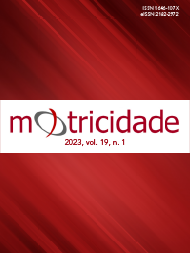The effects of preventive shoulder exercises in electromyographic and pain levels in child swimming athletes - A before-after analysis
DOI:
https://doi.org/10.6063/motricidade.27461Keywords:
Electromyography, Pain, Shoulder, SwimmersAbstract
The aim of this study was to evaluate maximum voluntary contraction through surface electromyography in stabilizer shoulder muscles, as well as the clinical evaluation of shoulder injury in the pre, post, and detraining stages of specific training in child swimmers. Twelve competitive swimmers volunteered for this study. Anthropometric measurements, clinical examination, electromyography (with Delsys® data acquisition system), and pain intensity levels were performed. Clinical examination and EMG data were compared using repeated-measures ANOVA with Bonferroni correction pre, post, and after detraining. The intervention program lasted for 12 weeks. The pain group presented higher pain intensity values compared to the post-intervention program. Most of the tests presented lower values at the detraining compared to the baseline. After the intervention, pain levels significantly decreased in five tests. Muscle strengthening work is highly recommended because it improves the swimmer's shoulder performance, reducing injuries and decreasing pain intensity after 12 weeks of intervention.
Downloads
Published
Issue
Section
License
The authors of submitted manuscripts must transfer the full copyright to Journal Motricidade / Sílabas Didáticas Editions. Granting copyright permission allows the publication and dissemination of the article in printed or electronic formats, and copyrights start at the moment the manuscript is accepted for publication. It also allows Journal Motricidade to use and commercialise the article in terms of licensing, lending or selling its content to indexation/abstracts databases and other entities.
According to the terms of the Creative Commons licence, authors may reproduce a reasonable number of copies for personal or professional purposes, but without any economic gain. SHERPA/RoMEO allows authors to post a final digital copy (post-printing version) of the article on their websites or on their institutions' scientific repository.


